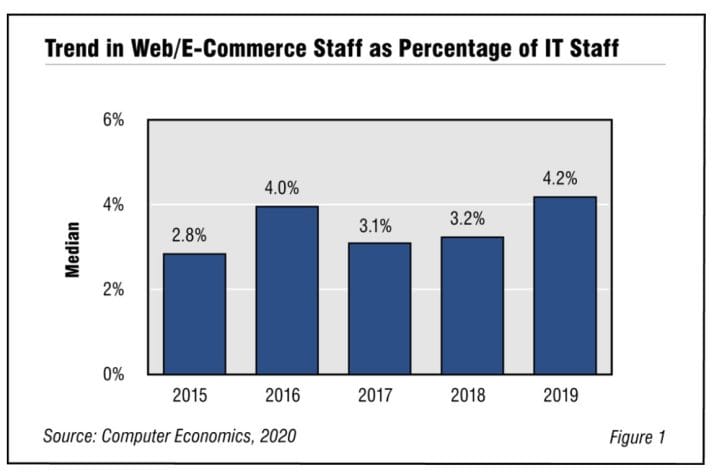Even before the COVID-19 pandemic, web/e-commerce support personnel played a critical role in companies, and the function was of increasing strategic value. Social media, mobile devices, and multimedia increase the ways that customers and suppliers interact with one another, while big data analytics are providing deeper insight into customer behavior. Now, this IT staff position is getting a big boost as shelter-in-place orders affect millions of people across the world, and companies seek to increase their digital interactions with customers, suppliers, and partners.
Whether it is telehealth in the healthcare sector, virtual government services, or online classes, nearly all sectors are being transformed by web and mobile e-commerce. Even when life returns to normal, consumers and workers will expect that much more business interaction can take place with digital technology.
Figure 1 from our full report, Web/E-Commerce Staffing Ratios shows that the percentage of the IT staff dedicated to web/e-commerce spiked to 4.2% at the median in 2019, the highest percentage in five years. That is up from 3.2% the prior year. Web/e-commerce staffing has always been relatively volatile, as it represents a smaller portion of a large IT staff, and is therefore prone to larger swings. Still, we expect the “new normal” following the COVID-19 outbreak to drive more growth in the web/e-commerce job function.

“Long before the pandemic, we predicted that the growth of online commerce and mobile applications would boost the need for web/e-commerce experts,” said Tom Dunlap, research director for Computer Economics, a research and consulting firm based in El Segundo, Calif. “Now, with the pandemic forcing people to use digital technology more in their daily life, organizations in every sector are having to accelerate their web/e-commerce initiatives. That makes developers for these systems a hot commodity.”
Our definition of web/e-commerce staff includes web developers, designers, administrators, and other individuals who work on the company’s public websites, as well as those who maintain intranet sites. It also includes personnel who are dedicated to e-commerce activities, such as EDI specialists. We have a separate staffing category for personnel supporting communications and messaging systems.
When considering the ratio of web/e-commerce personnel, it is helpful to keep in mind that the size of web/e-commerce support operations varies widely by industry sector, depending on an organization’s need for e-commerce and online customer service. For CIOs to calibrate their staffing requirements, the full report provides benchmarks for staffing functions related to web and e-commerce development and operations. We benchmark web/e-commerce staffing with two ratios: web/e-commerce staff as a percentage of the IT staff and users per web/e-commerce staff member. Finally, we examine the influence of sector on web/e-commerce staffing.
This Research Byte is a brief overview of our report on this subject, Web/E-Commerce Staffing Ratios. The full report is available at no charge for Avasant Research subscribers, or it may be purchased by non-subscribers directly from our website (click for pricing).





